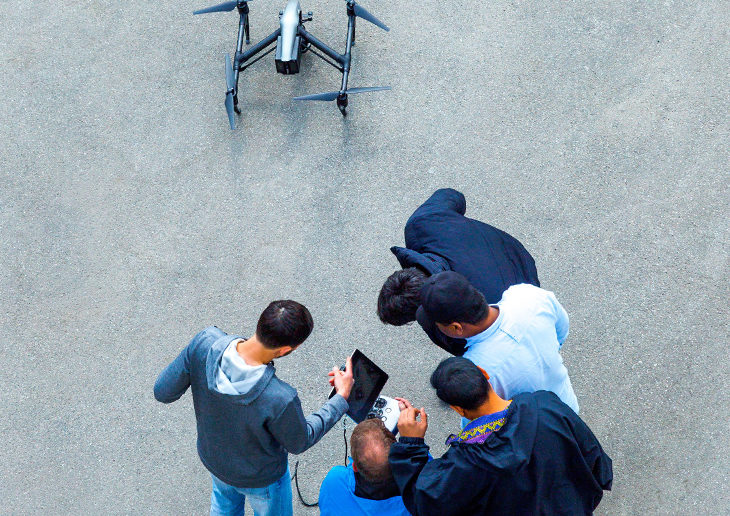Orange County “Takes Off” with Innovative Drone Education Collaborative Programs
February 28, 2020

Remember how the internet completely reinvented the way business—and literally everything else—was done? Then buckle your seatbelts and get ready for drones.
Over the next five years, Goldman Sachs estimates $100 billion of growth in the commercial drone industry, and their report says that’s just “the tip of the iceberg.” From agriculture to fire safety to business and beyond, this skyrocketing technology is launching a whole new workforce, and Orange County is ready for takeoff.
At the forefront of drone career education are the five Orange County community colleges who formed the Autonomous Systems Collaborative (ASC). Kickstarted by Orange Coast and Cypress, and joined by Fullerton, Santa Ana, and Golden West colleges, the ASC is a groundbreaking regional effort that is crossing traditional college and institutional divisions, thinking outside of existing educational codes, and uniting faculty from across the region to innovate education for future-minded drone careers.
“It’s been an interesting process to be part of because nobody had done it before,” says Lisa Knuppel, dean of career education and career services at OCC, where it all began.
In 2015, faculty from OCC’s computer science and aviation programs came to Knuppel with the idea to develop a multidisciplinary drone program. Knuppel wanted to take drone education even further and reached out to the previous career education dean at Cypress College, Steve Donley. They agreed that the project had the potential to benefit the entire region, and put forward a funding proposal in 2016, the first year of the regional Strong Workforce Program. Soon after, a regional grant was approved, and one by one, the five colleges joined forces to create the drone workforce of tomorrow.
“This was a very viable innovation,” Knuppel explains. “There were already catch points for it out in the world and people out there developing this technology.”
The ASC identified 14 industry sectors and 110 jobs that are just the beginning of the opportunities available in the rapidly expanding drone market.
People may not realize, but the first step to becoming a drone pilot is understand the rules of the road—which in this case is the sky. Currently, at OCC and Cypress, students are getting their Part 107 commercial certifications through the FAA, with programs at Santa Ana and Fullerton underway.
“Just getting the Part 107 certificate is a really big deal,” says Josh Friedman, technical assistance provider (TAP) for OCC and the ASC, and owner of One Zero Digital Media, which specializes in aerial video and photo services. “We’ve seen a ton of students already at OCC and Cypress get certified so that they can start careers as commercial drone operators in the U.S.”
But pilot credentials are just the beginning. Each college also has its unique areas of specialization, adding to the diversity of drone education in the region.
“All of us can’t do the same thing, nor should we,” says Knuppel. “This is what makes it regional.”
Cypress’s initial focus on aviation has expanded to include drone photography. Meanwhile, OCC began with aviation and programming, added digital media, and is currently working on agricultural courses set to start next spring. Golden West hopes to explore the possibility of adding drones into their police academy, while Santa Ana has programs spanning business and entrepreneurship, engineering, digital media, robotics, and drone mechanics.
“Santa Ana College has so many different industry sectors that were interested in workers with these skills that they’re introducing seven new classes over the next year and a half,” says Friedman. “They hired a consultant to oversee the whole thing.”
SAC’s course offerings include fire safety, where drones are used to inspect electrical lines and survey high-risk fire areas. “At our annual summit, we had incredible interest from the local fire and police,” says Knuppel. That’s when Santa Ana started talking with public safety, and, according to Knuppel, “that’s where they want to grow.”
At Fullerton, an entire drone lab has been developed with a multidisciplinary approach. Students with diverse career goals learn a variety of workforce-based drone applications, including inspection, form mapping, cinematography, and visual observation for public safety. Classes are listed under TECH, a “catch-all” for career education courses not grounded in one discipline.
According to Jay Seidel, journalism professor and head of the Fullerton Drone Lab, the open format encourages cross-pollination between all aspects of career education and STEM.
“It makes it more appealing for other disciplines to connect with and incorporate [drone technology] into degrees and certificates,” says Seidel. “This technology is broad and impacts so many fields and industries. Why restrict it?”
At Fullerton, students also gain real-world experience in multiple independent studies with drones, including observing shark ranges with California State University, Long Beach. Other opportunities include working with BNBuilders in construction to capture data for maps, and with University of California Agriculture and Natural Resources, collecting data on plant growth.
“We’re trying to provide an ecosystem for students,” says Knuppel. “It’s finding the points of intersection between this technology, the way jobs are emerging across all these sectors, and then finding the points that match with existing things at the colleges.” The idea is to create complimentary programs in drone technology that provide the breadth and depth students need to enter the expanding industry.
On top of new drone programs and industry-standard equipment across the schools, the ASC also launched the website CaliforniaAutomated.com, an online tool for connecting students, colleges, and businesses.
The website includes California Drone Connect, an interactive map that displays all of the middle schools, high schools, community colleges, and state universities in California with drone programs. Searchable by sector, students can survey course offerings at all schools—even better, they can also pinpoint regional businesses that are hiring.
“We’re creating partnerships and pathways,” says Friedman. “So students can go straight from the college and into the workforce with a local company.”
This April, the ASC will be celebrating its brand-new programs and website at an upcoming summit, where it will be discussing the creation of more pathways with its K-12 partners.
“We’re seeing drone education starting as early as kindergarten,” says Friedman. “There are a couple of third-grade classes in the Orange Unified School District that are teaching coding and robotics and are literally programming these drones.”
For Friedman, this is just the beginning of the K-12 opportunities. Currently, the ASC is creating a high school pathway for drone piloting that encompasses Adobe Photoshop, robotics, and aviation classes that will include the Part 107 certification.
“We have to forge new paths through our existing structures,” says Knuppel about the ASC’s innovative work. “We’re training people for the jobs that will exist in the future.”
It’s this kind of forward thinking that is inspiring students to take to the skies. That, and the expertise and enthusiasm of Orange County’s community college instructors.
“If it wasn’t for Professor Jay Seidel, all the hard work he put into the Fullerton College drone program and his infectious enthusiasm, I would never have been so inspired to become licensed as an FAA drone pilot,” says Sean Semple, a Fullerton student and entrepreneur. After receiving his training, Semple created a drone business called TesserRaptor UAV that does freelance drone aerial videography.
“Anytime you can do something that you find incredibly fun and turn that into a career, it doesn’t get better than that.”
For more information about the regional drone collaboration, visit https://CaliforniaAutomated.com




